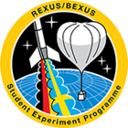Version 1.5b Castle in the Sky
lecture: REXUS/BEXUS - Rocket and Balloon Experiments for University Students
How to bring student experiments into space.

The REXUS/BEXUS programme allows students from universities and higher education colleges across Europe to carry out scientific and technological experiments on research rockets and balloons. Each year, two rockets and two balloons are launched, carrying up to 20 experiments designed and built by student teams.
By reference of two experiments we were involved in, we will explain the way from the experiment idea to the launch and test of it.
Bringing an experiment into space aboard a sounding rocket or into the higher atmosphere aboard a balloon is not as hard as one might think. Students from Europe can simply write a proposal and apply for the REXUS/BEXUS programme, which is realised by an agreement between the German and Swedish space agencies, DLR (German: Deutsches Zentrum für Luft- und Raumfahrt) and SNSB (Swedish National Space Board, Swedish: Rymdstyrelsen). The Swedish share is furthermore accessible to teams from other European countries through ESA.
For REXUS, two sounding rockets are launched from northern Sweden every year, each one capable of carrying up to 5 experiments (max. experiment payload mass approx. 40kg) to an altitude of 80-90km. The experiments have to be engineered to withstand at least 20g of acceleration during ascent and descent, and experience milli-gravity when close to the apogee. In addition, the space specific thermal and vacuum environment need to be considered. Since the altitude is too low for reaching an orbit, the rocket motor and payload falls back to ground and is recovered by helicopters. The experiments are then returned to the student teams and the data from the 10min flight can be analysed, for instance, atmospheric measurements or technology demonstrators.
Similarly for BEXUS, two balloons per year are launched from the same location in Sweden and allow for carrying up to 12 experiments (max. 100kg). The balloon lifts the gondola with inside experiments to an altitude between 25-30km. After some hours of floating, the balloon is separated and the gondola descents on a parachute. The payload is then recovered by a helicopter and returned to the launch site by truck.
During the talk we will present two experiments which we were involved in:
- Fiber Optical Vibration Sensing Experiment launched on RX15 in May 2014, and
- Advanced Receiver Concepts for ADS-B Experiment launched on BX18 in October 2014
Beside this, we will explain, how other interested students can participate in the next REXUS/BEXUS cycle.
Info
Day:
2015-12-27
Start time:
12:45
Duration:
01:00
Room:
Hall 6
Track:
Science
Language:
en
